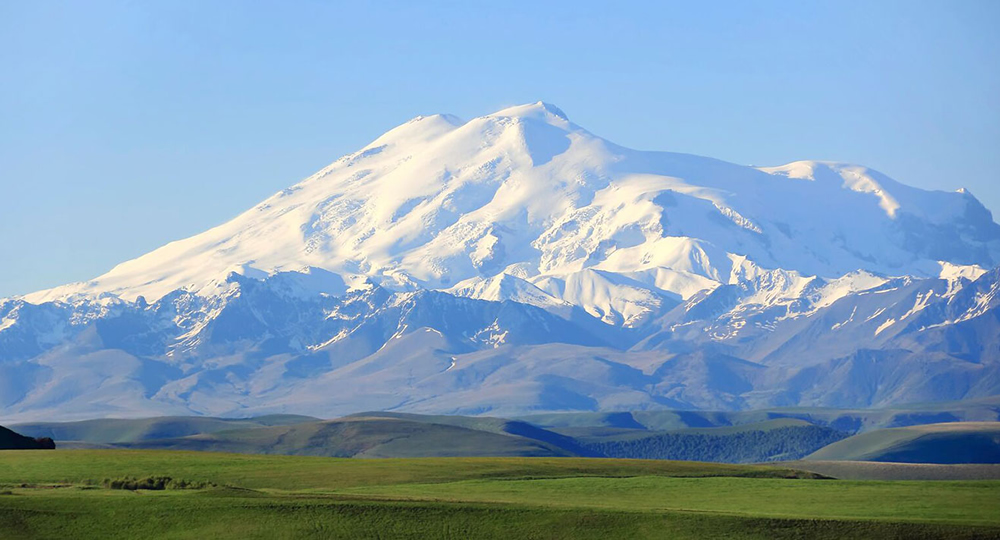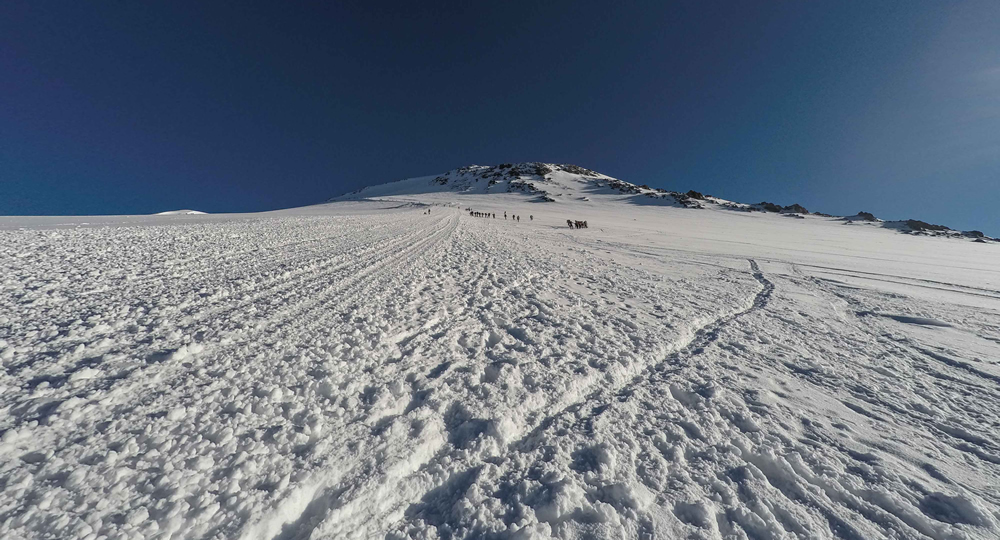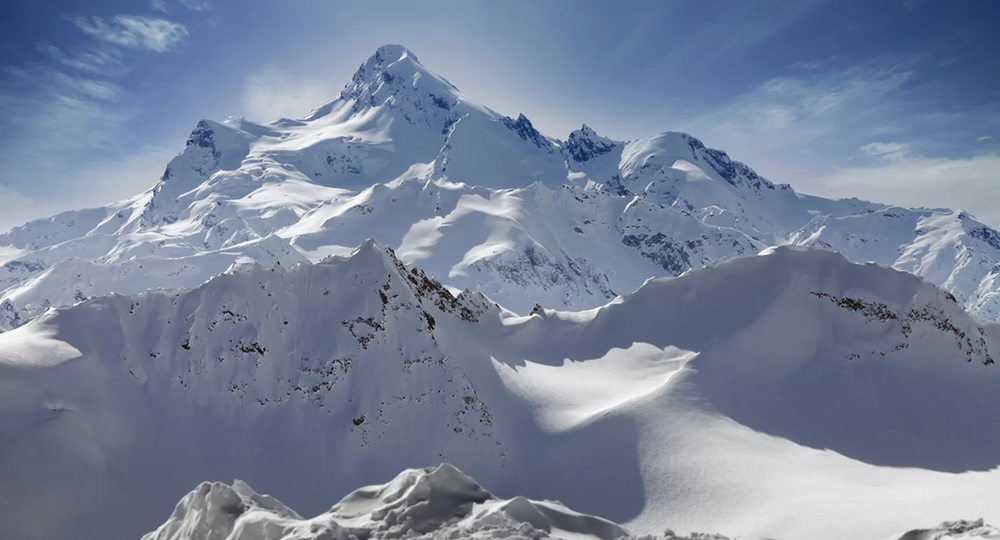- ALTITUDE – 5642 meters
- SIZE – 12 (FLEXIBLE FOR PRIVATE GROUPS)
- TRIP START/END –
- TRIP Best Season –
- Trip Duration –
Mount Elbrus
Overview
Mount Elbrus is the highest peak in Europe, and one of the Seven Summits. It’s located just in Russia, though it is only a few miles from the border of Georgia. It presents a strenuous and rewarding climb, but also includes a full experience of Russian culture, history and character. The ascent of Mt Elbrus by the north route is a long climb over a moderate incline (average 35 degrees, with some sections on the summit day increasing to 40 degrees) that requires good acclimatization but present few technical difficulties. However, despite the apparent simplicity of this route, it can be dangerous. The altitude, variable weather, and often low temperatures can transform the ascent into a real mountain adventure!
Mount Elbrus is not technically difficult but there is the danger of weather and exposure, making it cold and committing; it is necessary to have crampons, warm clothing, and good boots for summit day (preferably plastic or at least capable of taking a crampon – these are available to hire in Terskol. Ropes are not necessary on the northern route and the team will need to be roped up from the top hut to the summit and back.
With an elevation of 5642metres, Mt Elbrus is a fine ascent which requires mountaineering skills, although altitude and unpredictable weather make for a challenging and adventurous trip. It is perfect for people who wish to gain ice and snow experience as full training is given, for those wishing to climb the Seven Summits and for people who have aspirations of going on to climb higher peaks in the Himalayas.
From the Barrels Hut, head south and up the slopes to the Diesel Hut location at 4157 meters (13,638) feet elevation. The trail is usually well packed by snow cat and takes about an hour. From the Diesel Hut, continue south up the slopes while heading straight towards the East Peak. Make sure to stay on route because the surrounding slopes are covered with huge crevasses. There are no crevasses of consequence as long as you stay on route. You will pass between two linear rock bands before the route becomes steeper and climbs to the Pashtuhova Rocks, located at 4670 meters (15,321 feet) elevation. After the Pashtuhova Rocks, the route first heads south towards the East Peak, but after a short distance, it turns left and heads more in a westerly direction as it climbs up the slopes. The route reaches a gentle-sloped snow filled basin before climbing up to the saddle between the two peaks. There are ruins of an old hut at the saddle. Cross the broad slope to the summit. Total elevation gain from the Barrels hut is 1743 meters (5718 feet), and the climb usually takes 6-9 hours up. Descent usually takes 3-6 hours.
Itenary
-
Day 01
Meeting at Mineralnye Vody airport at 14:00. Our English-speaking guide will be awaiting you outside of the arrival hall at the airport. Bus ride (3,5 h.) to a mountain hotel in the Baksan valley near the foothills of Mt. Elbrus. There are twin and triple rooms in the hotel, with toilet and shower. Single accommodation may be available for additional cost in case there are vacant rooms in hotel or if you ordered that in advance. Overnight at the hotel (2300 m/7546ft).
-
Day 02
Acclimatization hike to Mt. Cheget (3400 m), 4 hours up and 1,5 hour down. This is the last day before you leave the valley and after hike you can visit equipment store in order to hire something. Our guide will assist you to choose right equipment items. Overnight at the hotel.
-
Day 03
This is the day when you move to the mountain refuge at 3800 m. You can leave all not necessary stuff at hotel. It will not be necessary to carry your backpacks self because the group will reach the refuge using ski lifts. There will be only a short distance to walk from the cable cars last station to the hut. You will be kindly asked to help the guide to load the boxes with food onto the ski lifts and then to unload it. The cook will either ascend with you or already awaiting you at the hut preparing light lunch. After having tea or coffee with sandwiches and sweeties we put on all mountain equipment and go for acclimatization hike up to 4300 m/14107 ft. Overnight at the refuge.
-
Day 04
Hike up to the Pastuckhov rocks and probably higher (4800 m/ 15,748 ft), 6 hours up and 2 hours down.
-
Day 05 – Rest & acclimatization day in Namche
Day of relaxation. On this day you will have ice- and snow courses with your guide not far from the refuge. The guide will teach you how to put on the crampons and how to walk in it; he will show you techniques of self-arrest with an ice-axe and you will try to slide down the slope and then fix yourself on the snow using your ice-axe and the crampons. Don’t worry when you’ve never tried it before. Overnight at the refuge.
-
Day 06 – Trek to Deboche
Summit day. We leave the refuge about 3 a.m. for the climb of Elbrus’ west summit, 5642 m (18,510 ft). It is possible to hire a snow-cat (Ratrak) for a group. This vehicle carries climbers (12 people) up to Pastuckhov rocks and saves 4 hours and a lot of energy. Generally, for an average group, it takes about 9 hours to reach the top and 5 hours to come back to the hut. Generally we stay at the refuge this night. If a group comes back from the top before 2 p.m. we can discuss the possibility to descend to the valley and have overnight at the mountain hotel. However this will require additional payment for hotel, because this night is paid for the huts.
-
Day 07
This is a reserve day in case of bad weather on the previous day. Overnight at the hut.
-
Day 09
Drive to Mineralnye Vody airport early in the morning to be in time for the flight which departs at 12:35. If you need to be at the airport earlier or your flight departs much later than11:35, you can order an individual transfer.
Day 08
One more reserve day in case of the bad weather or excursion. When the group takes an attempt of reaching the summit on this day, it is necessary to descend to the valley same evening by all means, because the ski lifts stop working at 4 p.m. Overnight at hotel.
THE PRICE DOESN’T INCLUDE
The Price Doesn't Include:
- International and Domestic Air ticket (ApproxRs.65,000/-)
- 4 Personal equipment & clothing (ApproxRs.60,000/-)
- Visa processing (Approx13,000)
- Insurance cost
- Personal expenses like drinks, laundry, etc.
- Tips to the staff.
Gears
- Travel/town clothes (can leave extras in hotel in KTM)
- Sun hat suitable for snow conditions
- Sunglasses: Category 3 or4, glacier type, UV & polarized are best
- Snow goggles (as for skiing)
- Warm (fleece/wool) hat or beanie
- Fleece scarf or neck gaiter AND balaclava
- 1-2 pairs of thermal liner gloves
- Windstopper fleece gloves
- Heavy mitts with waterproof shell (note: mitts not gloves)
- T-shirt/long-sleeved shirt
- 2 Thermal tops
- Fleece jacket or pullover mid weight
- Fleece jacket heavy weight
- INCL Mid-heavy weight down jacket
- Rain and wind-proof jacket, preferably Gore-Tex
- Rain and wind-proof pants (best with full side zips)
- Trekking shorts&/or long pants lightweight
- 1-2 Thermal long pants
- Fleece long pants, mid weight
- Several pair’s socks and underwear
- Trekking boots – we suggest strong leather boots
- Warm boots for camp (e.g. sheep skin boots) *Optional but great!
- Sun screen, zinc cream and lip balm
- Wash kit (small personal toiletries, nail clippers and pack towel)
- First aid kit and blister kit
- Personal medicines including your usual medicines
AND 1 course each of (usually available in Kathmandu): - Respiratory antibiotic (e.g. Amoxycillin)
- Gastrointestinal antibiotic (e.g. Ciprofloxacin)
- Gastro treatment (e.g. Imodium)
- Mild pain killers (e.g. Aspirin/paracetamol/ibuprofen)
- Throat lozenges
- Altitude medication (e.g. Diamox)
Day pack 70L – 85L
- Down suit
- One sport millet shoes
- Water containers: minimum 3L: e.g. Nalgene wide mouth bottles 1L + bottles or bladder another 2L capacity
- INCL Foam sleeping mat
- An extra sleeping mat (*recommended; e.g. Thermo-Rest or Ridge Rest
- 1 Summit down sleeping bag for high camps
- INCL Sleeping bag for base camp and trek use
- Water-proof bag for sleeping bag (e.g. dry bag or robust plastic bag(s))
- Head lamp (we suggest Black Diamond with LED), spare batteries
- Pee bottle — wide mouth Nalgenes are good *Optional
- Crampons Alpine style with rapid-fix bail type to suit your boots (e.g. Black Diamond Sabretooth)
- Gaiters (for snow) appropriate to your plastic & trekking boots
- Adjustable trekking pole(s)
- Ice axe: one only, 65-75cm in length
- Climbing harness with a belay loop, adjustable leg loops
- Belay/Abseiling gear: e.g. Black Diamond ATC
- Ascender e.g. Petzl expedition ascender
- 2 Non-locking carabineers
- 2 Locking carabineers (wide gate preferred)
- INCL Group medical kit (for altitude illness, trauma, reserve antibiotics); emergency oxygen and portable altitude chamber
- INCL Satellite phone (pay for air time used: USD /minute)
- INCL Sleeping tents, dining tent, all cooking and eating equipment & food on trek/climb
- INCL 240VAC generatorat BC to recharge camera batteries
- INCL Barrel or duffle bag for transporting personal gear by Yak and truck
- INCL Climbing ropes, fixed safety ropes
- INCL Snow anchors, ice anchors, rock anchors, v-thread cord
- R: This item is available to rent
- INCL: This item included in package

Would you like this trip?
FREQUENTLY ASKED QUESTIONS
Triumph Expeditions trip web pages and pdf info packs have lots of info about each specific adventure (search for your adventure here). You may also like to look at our photo galleries or videos for a taste of adventure or download a wallpaper to inspire you at your computer. This page has answers to some more general Frequently Asked Questions (FAQS) about climbing.
As all of our mountain climbing adventures begin with a trek, you might also like to look at the Trekking FAQs.
If you have other questions, please ask our friendly team, by email, phone, and Skype.
A) The level of experience and skills required depends on your particular goal (search for your adventure here). We suggest that people undertaking the first climb should have had at least overnight trekking experience. For those who wish to take on a technically difficult, remote or extreme altitude mountain we’d expect participants to have appropriate experience and skills. Some ideas for preparing for climbing goals are given at the bottom of this page.
A) There are many reasons that might make a guided expedition attractive even for experienced climbers. These include someone else taking care of all those details (including thing as diverse as booking and confirming hotels, checking the number of evening snacks, ensuring reliable support, transport, permits, visas, team members, gear, etc etc etc etc). This saves your time and energy for the part that really matters – working on achieving your goal. The high levels of support and experience aim to give you the best possible opportunity to succeed, a high level of risk management, and the Triumph Expeditions leaders and staff are there for YOU!
A) Climbing expeditions usually attract people in their twenties to fifties. Participants tend to be seeking a good quality, safe, well supported, good value and enjoyable adventure rather than the lowest cost.
A) The fitter you are, the more fun you (and your companions) will have. You will find guidance on preparing for your expedition on each adventure’s web page (search here), our info packs and trip dossiers. A minimum level of fitness would have you being able to walk all day on uneven, hilly ground, carrying your day pack, and be able to get up again the next day. Many climbs will require a higher level of fitness and strength so you can carry heavy gear to high camps and really exert yourself on summit day.
A) Included are individual sleeping tents for the trekking phase of most climbing expeditions, with dining and kitchen tents. On the mountain, participants share serious, proven mountain tents. Climbing teams are equipped with emergency communications and first aid equipment as well as more prosaic things like climbing and cooking gear. There is a detailed gear list for each adventure which outlines what we provide as well as what you should bring. (Search here for specific adventures and download the info pack.)
A) Food arrangements are specific to each adventure, but you get three meals a day while on the track. In cities included is breakfast and, depending on the trip and the nature of the activities may also cater for lunch and dinner for the group. In the Himalayas, the kitchen staffs have been training for years and work magic over gas or kero stoves in their kitchen tent.
While trekking the cooks prepare a varied menu of wholesome, tasty and plentiful food using fresh ingredients where possible. A trekking breakfast in the Himalayas usually includes cooked foods e.g. eggs, tomatoes, cereal or porridge, toast & spreads and fruit and a selection of hot drinks.
Lunch is often soup and a packed lunch, or a cooked lunch. Dinners are generally soup, the main meal (one of many Asian or European style dishes) veges, and a dessert (fruit to custard to baked apple pie!) Drinking water: will be provided at camps (collected with care, filtered, treated with chemicals and/or boiled), and at lunchtime where possible. It is wise to carry a small amount of purifying chemicals (e.g. Iodine or chlorine) with you, in case you happen to need water at an odd time. In the developing world, care should be taken to avoid untreated water and potentially contaminated foods like uncooked salads and some fruit. Bottled water is available in cities, but of course, you can treat tap water in your own bottle too.
On the hill, we eat easy to prepare food, often prepared by the team with assistance from guides and staff: freeze-dried foods, crackers, soups, snacks etc. On big mountains it is often a challenge to eat, so we provide foods to tempt your appetite and give you sustenance.
A) The short answer – you! All participants are expected to behave in a responsible manner, taking due care of themselves and others. Your expedition leader is responsible for the group including participants and staff. He or she will advise, manage and assist everyone, sometimes with the support of an expedition first aider or doctor, and will be assisted by guides, sherpas, and you and your climbing colleagues, all of whom will have roles to play.
A) Despite the best precautions, people do sometimes fall ill, sprain something or develop symptoms of AMS. Our expedition leaders will manage your care keeping in mind what’s best for you and the rest of the group. Precautions include first aid qualifications and kits, emergency communications, evacuation plans, your travel insurance cover and our pre-preparation and medical advisors.
A) AMS Acute Mountain Sickness (or altitude sickness) is the body reacting to the stress of high altitude. It is a concern for trekkers in the Himalayas and elsewhere above about approximately; say (is that enough vagueness!) 3,000m. Exposure to high altitude can lead to a number of ‘normal’ physiological reactions as well as mild to extremely serious illness and even death. The treks are designed with acclimatization schedules, rest days and alternative options. And there are medications and a number of management strategies in place should they be required. Don’t be unduly concerned, but please talk to us if you have questions.
A) The adventures are designed around what we feel is the optimum itinerary, which incorporates adequate time for the suitably fit participant to do the climb comfortably; flexibility for weather, illness, unforeseen delays; time to enjoy the experience, your climbing colleagues and staff; learn about your surroundings if you wish; and, for altitude adventures, a fairly slow acclimatisation regime to minimise the risk of altitude sickness and maximise your chance of reaching your goals. All while also trying to minimise your time away from home. We would generally not recommend shorter itineraries (such as those used by less scrupulous operators) unless you were genuinely prepared to turn back if you (or your travel companion) becomes affected by AMS. If you really don’t have the time available, we can perhaps suggest an alternative itinerary or goal that will work for you.
A) Your friend, spouse, family, colleagues may like to join you on the trekking phases the expedition, and could stay in Base Camp or Advanced Base Camp, depending on the trip, when you are on the hill. If they want to accompany you to our base city (e.g. Kathmandu) we can easily arrange extra accommodation and places on our day tours, but we may also be able to arrange a series of day trips, a short relaxing trip into the country-side, scenic flights above the Himalayas, wildlife safaris and so on. Ask us for ideas, or suggest your own.



 WhatsApp us
WhatsApp us